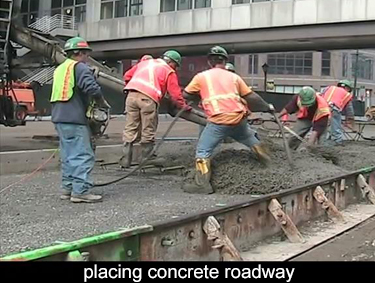They may actually perform the pressure test themselves. When the utility is finally complete and ready to be tied into the existing system, that is usually done by the utility company. You can see that the ongoing close relationship with the utility companies is critical. That begins at the design phase and it needs to continue throughout the construction phase.
 There is another view here of an additional gas main being installed. You can see the arrangement here of the geotextile fabric, then the placement of some sand and the gas main will be placed in that sand bed and then fully encased in sand and wrapped with the fabric. There's a jig here on the right hand side, which is assembling the pipes and I'll show you what that process is. These are plastic pipes. They are very light. They're very easy to handle. The material is high density polyethylene and the joints are made by fusing sections together.
There is another view here of an additional gas main being installed. You can see the arrangement here of the geotextile fabric, then the placement of some sand and the gas main will be placed in that sand bed and then fully encased in sand and wrapped with the fabric. There's a jig here on the right hand side, which is assembling the pipes and I'll show you what that process is. These are plastic pipes. They are very light. They're very easy to handle. The material is high density polyethylene and the joints are made by fusing sections together.
Of course, you have to make a perfect saw cut. It has to be perfectly square, so that the ends meet exactly. There's a jig set up to allow you to do that. You couldn't possibly do that by hand. This machine guides the cutting effort and will also fuse the pieces of pipe together. That is done by applying heat. There's a kind of pancake-shaped device, which is heated to the right temperature, then it's inserted between the pipes and it softens the plastic to the point where that jig can bring the pipes together, The pipes are held together until that fuse joint is completed.
 There's something always satisfying about placing concrete. To begin with, it marks the event of having completed all of the underground work. No one ever sees that effort and that effort is the most demanding and challenging effort. When you're finally placing the concrete, all of that is history and no one will ever know the hardships and the challenge that took place. Placing concrete is very satisfying. It's telling you that you've reached that point and you're creating this product that will be there for a very long time.
There's something always satisfying about placing concrete. To begin with, it marks the event of having completed all of the underground work. No one ever sees that effort and that effort is the most demanding and challenging effort. When you're finally placing the concrete, all of that is history and no one will ever know the hardships and the challenge that took place. Placing concrete is very satisfying. It's telling you that you've reached that point and you're creating this product that will be there for a very long time.
You're all familiar now with the metal form, the dowels, which will join the two pores together -and this basket of dowels, which are placed at the location of construction joints. The concrete here, if you look at the edge of the concrete, you can see it's quite stiff. It's probably a three or four inch slump. That, of course, is critical to achieving a very high strength result. There's always this ongoing desire to add more water, to make it a little easier to handle at the strike off. That has to be resisted, because that greatly reduces the ultimate strength of the concrete.